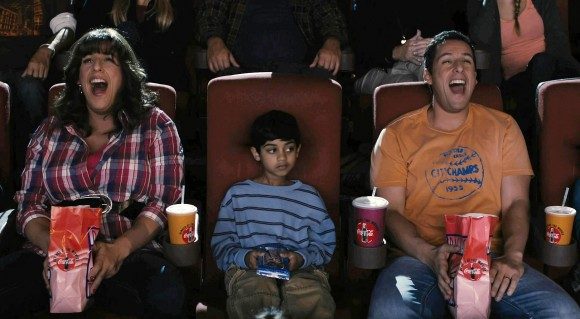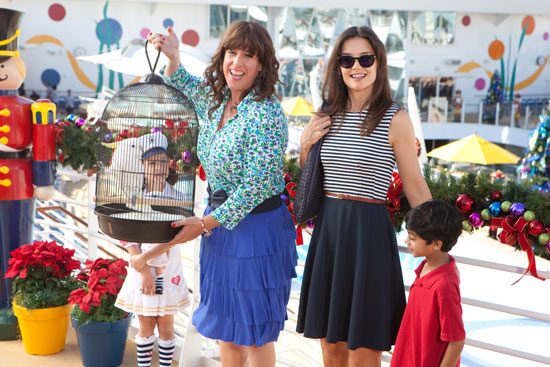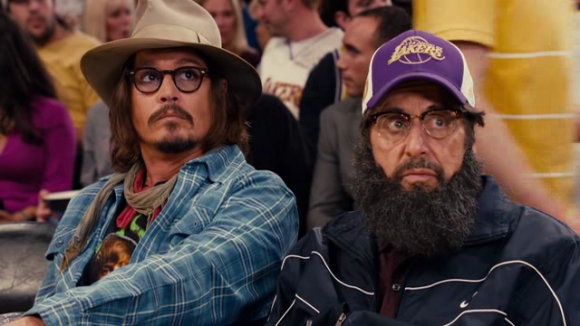In my article “The Legacy Question: Is It Better To Be Hated or Forgotten?” I commented on how one of the best components of truly bad films is that you want share them with others. And sometimes the more you watch, the more opportunity you have to pick up on details and subtext; the more the cry of “WHAT WERE THEY THINKING?!?” goes from being one of exasperation to being a legitimately curious inquiry into the thought process behind every film making decision. A type of bad movie Stockholm Syndrome (or Shlockholm Syndrome, if I dare to coin the term).
In honor of Thanksgiving this week, I am taking another look at one of the most loathed works of the past five years as well the highest grossing Thanksgiving film of all time – Adam Sandler’s Jack and Jill (2011). It’s a film that, at first glance, is easily one of the worst things ever to hit cinemas. But with subsequent viewings, you begin to realize that this is Art House Adam, and his most experimental film since Punch–Drunk Love.
Without question Adam Sandler is a genuine comedy star, among the biggest of all time. However, unlike leading men such as Peter Sellers, early Steve Martin, and even Will Ferrell, Sandler is not quite as adept at holding the screen by himself. Whether with a love interest or with one of his friends, Sandler needs someone to feed into him. He will always be the nucleus, but he needs those sub-atomic particles in his orbit, providing him with energy. This isn’t necessarily a bad thing. Comedic power is an elusive, indefinable thing, and figuring where you receive your strength is essential to obtaining any success. Sandler doesn’t just know it, he knows how best to harness it – which is why he generally surrounds himself with the same exact people in every film.
While some of his regulars appear in Jack and Jill, Sandler’s main on-screen partner in this film is…himself, and that leads to something far stranger and more disconcerting than his traditional fare. While some actors have mastered the craft of acting against themselves (e.g. Eddie Murphy, Jeremy Irons), Sandler simply has no idea what to do. His pacing is so off that he often crosses into Dramatic Sandler territory, where his cadence is slower and he waits to react rather than being ready to explode at a moment’s notice; in other words, actual acting.
This oddness reaches technical and emotional heights during the scenes that block Jack and Jill, i.e. Sandler and Sandler, together. The special effects required to put two Sandlers in one shot cost money, which this movie had more than enough of with a reported $79 million production budget. But more importantly, it costs time and effort, neither of which, seemingly, Sandler cared to spend. Most of the Jack and Jill scenes are incredibly simple and static scenes, often at night or in another dark location, which is an efficiency maneuver since darkness makes it easier to hide cuts, split screens, and other types of effects. These scenes also consist almost exclusively of Jack and Jill, with the rare extra character sticking to a single side of the screen because, again, it requires a lot more from people to create a composite shot with multiple moving parts.
At first glance, this labor saving device makes Jack and Jill look cheap and lazy. But it ends up successfully giving this film an overwhelming feeling of isolation and depression as both titular characters are shut off from the world and from one another.
For the individual characters, it becomes remarkably beneficial. Jack’s dislike of Jill doesn’t seem like the expected, “I can’t believe I have to put up with my stupid family!” zaniness, but more something akin to shame. Jill is his secret, something from his past that he has tried so long and so hard to bury. His frustration at her staying with him comes less from having to put up with her antics and more with him being caught in a major lie that defined his present life. (And make no doubt about it, Jack is the main character, probably because it requires a lot less effort for Sandler to put on a t-shirt than to put on fake breasts.)
By the same token, Jill is a character who is unsure of herself, uncomfortable in her body, and trying desperately to be liked – all of which relates to Sandler’s own discomfort in the cross-dressing, opposite gendered role, as well as the drive for anyone to become a massive star. His insecurities in playing the character even extend to the character’s own insecurities, which almost makes Jill sympathetic. She’s a gross human being to be sure (in response to diarrhea after eating Mexican food for the first time she has a “run for the border” joke), but Sandler’s inability to commit gives a strange humanity to this terrible character – it’s not just that she’s boorish, it’s that she simply doesn’t know better, or maybe is just trying to fit in with “what’s cool,” yet deep down knows that she’s wrong and can’t cut it.
Of course, Sandler isn’t the only person on screen. Katie Holmes, who herself achieved acting legitimacy in another of the few Thanksgiving features out there (2003’s Pieces of April) plays Jack’s hapless wife in what is one of the most thankless “lead”(?) female roles to ever appear in a comedy. More than a denial of any funny moments, Holmes’s Erin barely says anything at all. I’d be surprised if she says 15 lines throughout the entire movie. Mostly, she just stands around, silent and wide-eyed, like a hand servant to Jack and/or Jill. She doesn’t give the inspirational speech at the end or encourage change in either of the main characters or seem like a quality provider of emotional support. She’s just there to give a reason for Jack to have two adopted kids, neither of whom does anything either.
However, Jack’s complete and utter apathy towards his wife ends up being another fascinating component to his character because it’s not even a bad marriage, just one in which he has no investment. This is particularly notable considering the attention and heart Sandler has regularly given to his characters’ love interests and how trying to woo them over or woo them back is almost always a major plot point in his film and part of his appeal. In this film, Jack, both due to the embarrassment at Jill showing up and due to being caught in his lie, ends up divorcing himself so entirely that the permeating sense of isolation carries over to his relationship with other characters, even his own family.
Surprisingly, Sandler’s second (or third, depending on how you rank Jill) lead is Al Pacino as Al Pacino. Although painted as a cameo role in the ads, he almost certainly has the second highest screen time after Sandler him/herself. More shockingly, the S1m0ne star turns in a genuinely good performance – whether being himself, or trying to woo Jill like a latter day Pepe Le Pew, or method acting in public as The Man of La Mancha. Going all in, Pacino even manages to go over the top without devolving into self-parody, which he has difficulty doing even in more credible films.
Pacino is also the key component to the only thing this film has resembling a plot – Jack’s attempt to get Pacino for a Dunkin’ Donuts commercial. More than anything else, this is Jack’s driving force for the entire movie. Once he learns that Pacino has the hots for Jill, Jack’s quest to win over Al takes center stage and overtakes Jack and Jill’s relationship as its primary focus. Jack keeps Jill around to try and pimp her out to Al, Jack dresses as Jill (of course) to share a dinner in Al’s private manor while fending off his advances, and most notably the film even ends with Jack and Al together. After viewing the Dunkin’ Donuts commercial, Al pleads with Jack to “burn this” so that it never sees the light of day (obvious joke/symbolism is obvious), but the movie fades out on them bickering. Jack and Jill, which reasonably should end with something related to family – namely Jack and Jill – bizarrely closes with Jack and Al discussing business and with Jill nowhere to be seen or referenced. The end of the film is where all the lessons learned comes together,and for something purporting to be a family comedy (it’s even rated PG), that is family togetherness. Yet we leave on Jack still remaining apart from his clan and concentrating on business over family, a particularly strange choice .
Beyond these threads, everything else contributes to Jack and Jill’s feel as a surreal and uncomfortable experience. The film bookends itself with real life testimonials (and dancing) from actual twins in a documentary style approach that I don’t believe Sandler has appropriated before or since. It’s an off-putting way to start the film, but its novelty should definitely indicate that this is an unconventional film, even for Sandler. Initially a completely out-of-left-field way to welcome us into this universe, upon rewatches, the insecurity (of real people on camera) and lack of focus or interconnecting idea beyond “some people have twins” sets the tone of this movie perfectly.
The rest of the film similarly reflects Jack’s presumably depressed and distracted mindset. Barely any scenes have any impact beyond those to which they’re immediately adjacent. Yet it’s not really a comedy vignette movie since most of the segments exist in the middle ground between montage beat and fully realized scene. And this isn’t a joke-strewn movie either; a surprisingly large number of moments exist in that no-man’s-land between comedy and drama where neither jokes nor emotional relevance nor a plot-forwarding excuse of any kind can be found.
Perhaps more than any other of Sandler’s major release comedies, Jack and Jill seems adrift and completely without any internal rhythm. There are no real subplots to speak of – Jack seems to have the lazy writer’s epiphany that family is important (and prostituting your sister is inappropriate) because the movie reached the bare minimum of time necessary to be considered a feature film and finally has permission to end. While the film dips into absurdist humor a bit more than traditional Sandler fare, it never really reaches the level of manic energy necessary for a zany comedy. 

Viewing this film through the eyes of its main characters – Jack, a man so ashamed that he cuts himself off from everyone and everything besides his work, and Jill, a loathsome woman who knows she is but refuses to accept the truth about herself – gives this approach an extra level of depth. These are characters that hide themselves from the rest of the world and delude themselves so much that life passes them by and can never really enjoy themselves. (This is also a theme of the Sandler comedy-drama Click so it’s not completely outside of his purview, though he reached a different conclusion in that one.)
Much like the coasting existences of both Jack and Jill, Jack and Jill floats along in a weird, self-centered bubble. As with Sandler himself, the viewers find themselves trapped in a mistake they clearly want to get out of, but can’t. The lack of people (i.e. actors, extras), the missing energy, and a tangible desire to abort lead to an experience that comes across as more claustrophobic and isolated than a TV series’ bottle episode, while the lack of direction or passion from anyone involved causes a sense of depression, anxiety, and insecurity to seep from its pores the longer it goes on. Jack and Jill is certainly not a good film, but its subtle darker and more surreal edge certainly gives it a couple of extra points on the rest of Sandler’s oeuvre. Maybe there was method to this madness after all.



